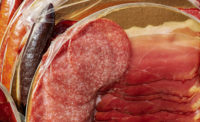Category Report: Smoked & Cured Meats
Liquid smoke offers flexibility for processing
The global market value for liquid smoke is expected to reach $245 million by 2033.

Photo credit: Fred Wilkinson
Surabhi Wason, food scientist for Kerry, says using liquid smoke lets processors capture the best of the smoking process while removing undesirable toxins.
OKLAHOMA CITY – Liquid smoke has a long history in the production of smoked meat products, and it can offer some benefits over traditional smoking methods.
During the 2024 Reciprocal Meat Conference in Oklahoma City, the Revolutionizing Food Preservation with Innovative Clean-Label Smoke Technology workshop session offered a brief history of liquid smoke’s use in smoking meats.
Workshop presenter Joshua Gurtler, lead scientist with the US Department of Agriculture’s Agricultural Research Service, shared an overview of the uses and regulatory status of liquid smoke for food applications.
Liquid smoke, traditionally called wood vinegar, is a natural flavoring agent that is made by burning wood chips and condensing the smoke into a liquid. Liquid smoke has been used for hundreds of years in places like Japan, China, Indonesia, Malaysia, Brazil, and Southeast Asia.
Though its use in the Americas dates to the Colonial Era, liquid smoke was first popularized and marketed the in the US in 1895 by Missouri pharmacist Ernest H. Wright, with farmers using it to cure meats. Gurtler said the 2023 global market value for liquid smoke was $93 million, and that is expected to reach $245 million by 2033.
The industrial application of liquid smoke to meat, poultry or seafood offers a number of benefits:
- enhanced color, aroma and flavor
- antioxidants and antimicrobials to fight microbial and oxidative spoilage.
- toxic compounds such as polycyclic aromatic hydrocarbons, waxes, resins, terpenes and metals are removed by refining condensates with phase separation and filtration
- reduction in harmful smoke emissions
- reduced employee safety hazards
- reduced labor costs for food application and cleanup
- increased throughput.
Gurtler said commercially marketed liquid smoke uses include:
- concentrated liquids for atomizing, or smoke regeneration in smoking/cooking chambers
- extracts added to meat via injection or mixing
- water-miscible solutions for direct liquid surface application
- powders added to carriers to provide smoke flavor
- condensates to be directly added to sauces for meat application.
Federal food labeling regulations allow liquid smoke to be listed as “smoke flavoring” or “natural smoke flavoring” on the ingredient deck. The label for meat products incorporating liquid smoke also must include wording such as “artificial smoke flavoring added” or “smoke flavoring added.”
According to the USDA’s Food Safety and Inspection Service’s 2024 Food Standards and Labeling Policy, "Meat or poultry products which have been exposed to natural liquid smoke flavor which has been transformed into a true gaseous state by the application of heat or transformed into vapor by mechanical means, e.g., atomization, may be labeled ‘Smoked.’”
Panelist Surabhi Wason, food scientist for Kerry, said using liquid smoke lets processors capture the best of the smoking process while removing undesirable toxins.
Wason said smoking of meat, poultry and fish has been increasing in popularity. The smoked products category, valued at $694 million in 2022, is expected to increase by 66% to $1.15 billion by 2032.
Wason said the use of liquid smoke allows processors to control the concentration of smoke being applied, helping ensure consistency of desired characteristics in the final product.
She said liquid smoke helps ensure not only product quality but also extend shelf life, while enabling processors to create products that allow consumer-friendly flavor labeling.
Looking for a reprint of this article?
From high-res PDFs to custom plaques, order your copy today!
.png?height=96&t=1647275041&width=96)






